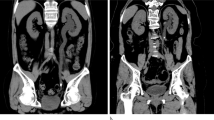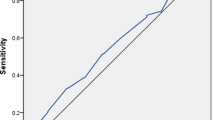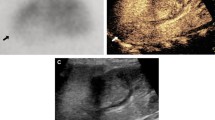Abstract
Hematuria can signify serious disease such as bladder cancer, upper urinary tract urothelial cell carcinoma (UUT-UCC), renal cell cancer or urinary tract stones. CT urography is a rapidly evolving technique made possible by recent advances in CT technology. CT urography is defined as CT examination of the kidneys, ureters and bladder with at least one series of images acquired during the excretory phase after intravenous contrast administration. The reasoning for using CT urography to investigate hematuria is based on its high diagnostic accuracy for urothelial cell carcinoma (UCC) and favorable comparison with other imaging techniques. The optimum diagnostic imaging strategy for patients with hematuria at high-risk for UCC involves the use of CT urography as a replacement for other imaging tests (ultrasonography, intravenous urography, or retrograde ureteropyelography) and as a triage test for cystoscopy, resulting in earlier diagnosis and improved prognosis of bladder cancer, UUT-UCC, renal cell cancer and stones. Current problems with CT urography for investigating hematuria might be solved with a formative educational program simulating clinical reporting to reduce reader error, and a new technique for image-guided biopsy of UUT-UCC detected by CT urography for histopathological confirmation of diagnosis and elimination of false-positive results. CT urography is recommended as the initial imaging test for hematuria in patients at high-risk for UCC.
Key Points
-
Hematuria can signify serious disease such as bladder cancer, upper urinary tract urothelial cell cancer (UUT-UCC), renal cell cancer or urinary tract stones
-
Patients with hematuria can be divided into low-risk and high-risk groups for UUT-UCC based on risk factors such as patient age, visible hematuria, occupational exposure to toxins and other factors
-
CT urography is defined as CT examination of the kidneys, ureters and bladder with at least one series of images acquired during the excretory phase following intravenous contrast administration
-
Reasoning for the use of CT urography to investigate hematuria is based on its high diagnostic accuracy for UUT-UCC and favorable comparisons with other imaging techniques
-
CT urography is recommended as the initial imaging investigation for patients over 40 years old presenting with hematuria (UTI excluded), specifically those at high risk of urothelial cell carcinoma (UCC)
-
The optimum diagnostic imaging strategy for patients at high risk of UCC is to use CT urography as a replacement test for conventional upper tract imaging techniques and as a triage test for cystoscopy
This is a preview of subscription content, access via your institution
Access options
Subscribe to this journal
Receive 12 print issues and online access
$209.00 per year
only $17.42 per issue
Buy this article
- Purchase on Springer Link
- Instant access to full article PDF
Prices may be subject to local taxes which are calculated during checkout



Similar content being viewed by others
References
Sutton, J. M. Evaluation of haematuria in adults. JAMA 263, 2475–2480 (1990).
Khadra, M. H., Pickard, R. S., Charlton, M., Powell, P. H. & Neal, D. E. A prospective analysis of 1,939 patients with hematuria to evaluate current diagnostic practice. J. Urol. 163, 524–527 (1999).
Edwards, T. J., Dickinson, A. J., Natale, S., Gosling, J. & McGrath, J. S. A prospective analysis of the diagnostic yield resulting from the attendance of 4020 patients at a protocol-driven haematuria clinic. BJU Int. 97, 301–305 (2006).
Kelly, J. D., Fawcett, D. P. & Goldberg, L. C. Assessment and management of non-visible haematuria in primary care. Br. Med. J. 338, a3021 (2009).
Malmström, P.-U. Time to abandon testing for microscopic haematuria in adults? Br. Med. J. 326, 813–815 (2003).
Rodgers, M. et al. Diagnostic tests and algorithms used in the investigation of haematuria: systematic reviews and economic evaluation. Health Technol. Assess. 10, iii–iv, xi–259 (2006).
Grossfeld, G. D. et al. Evaluation of asymptomatic microscopic hematuria in adults: The American Urological Association best practice policy-Part 1: definition, detection, prevalence, and etiology. Urology 57, 599–603 (2001).
Grossfeld, G. D. et al. Evaluation of asymptomatic microscopic hematuria in adults: The American Urological Association Best Practice Policy-Part 11: patient evaluation, cytology, voided markers, imaging, cystoscopy, nephrology evaluation, and follow-up. Urology 57, 604–610 (2001).
Webb, J. A. W. in European Uroradiology '94 (eds Dalla Palma, L. & Thomsen, H. S.) 36–39 (FADL, Copenhagen, 1994).
Webb, J. A. W. Imaging in haematuria. Clin. Radiol. 52, 167–171 (1997).
Van Der Molen, A. et al. CT urography: definition, indications and techniques. A guideline for clinical practice. Eur. Radiol. 18, 4–17 (2008).
Mahesh, M. MDCT Physics: The Basics—Technology, Image Quality and Radiation Dose 5–16 (Lippincott Williams & Wilkins, Philadelphia, 2009).
Mahesh, M. MDCT Physics: The Basics—Technology, Image Quality and Radiation Dose 17–35 (Lippincott Williams & Wilkins, Philadelphia, 2009).
Smith, R. C. et al. Acute flank pain: comparison of noncontrast enhanced CT and intravenous urography. Radiology 194, 789–794 (1995).
Smith, R. C., Verga, M., McCarthy, S. & Rosenfield, A. T. Diagnosis of acute flank pain: value of unenhanced helical CT. AJR Am. J. Roentgenol. 166, 97–101 (1996).
Sourtzis, S. et al. Radiologic investigation of renal colic: unenhanced helical CT compared with excretory urography. AJR Am. J. Roentgenol. 172, 1491–1494 (1999).
Fielding, J. R., Silverman, S. G., Samuel, S., Zou, K. H. & Loughlin, K. R. Unenhanced helical CT of ureteral stones: a replacement for excretory urography in planning treatment. AJR Am. J. Roentgenol. 171, 1051–1053 (1998).
Bosniak, M. A. The small (less than or equal to 3.0 cm) renal parenchymal tumor: detection, diagnosis, and controversies. Radiology 179, 307–317 (1991).
Silverman, S. G. et al. Small (< or = 3 cm) renal masses: correlation of spiral CT features and pathologic findings. AJR Am. J. Roentgenol. 163, 597–605 (1994).
Zagoria, R. J. Imaging of small renal masses. AJR Am. J. Roentgenol. 175, 945–955 (2000).
Warshauer, D. M. et al. Detection of renal masses: sensitivities and specificities of excretory urography / linear tomography, US, and CT. Radiology 169, 363–365 (1988).
Caoili, E. M. et al. Urinary tract abnormalities: initial experience with multi-detector row CT urography. Radiology 222, 353–360 (2002).
Chow, L. C. & Sommer, F. G. Multidetector CT urography with abdominal compression and three-dimensional reconstruction. AJR Am. J. Roentgenol. 177, 849–855 (2001).
Kawashima, A. et al. CT urography. RadioGraphics 24, 235–254 (2004).
Anderson, E. M., Murphy, R. M., Rennie, A. T. M. & Cowan, N. C. Multidetector computed tomography urography (MDCTU) for diagnosing urothelial malignancy. Clin. Radiol. 62, 324–332 (2006).
Nolte-Ernsting, C. & Cowan, N. Understanding multi-slice CT urography techniques: many roads lead to Rome. Eur. Radiol. 16, 2670–2686 (2006).
Dillman, J. R., Caoili, E. M. & Cohan, R. H. Multi-detector CT urography: a one-stop renal and urinary tract imaging modality. Abdom. Imaging 32, 519–529 (2007).
Silverman, S. G., Lyendecker, J. R. & Amis, E. S. What is the current role of CT urography and MR urography in the evaluation of the urinary tract? Radiology 250, 309–323 (2009).
Weinstein, S., Obuchowski, N. A. & Lieber, M. L. Clinical evaluation of diagnostic tests. AJR Am. J. Roentgenol. 184, 14–19 (2005).
Stacul, F. et al. Contrast induced nephropathy: updated ESUR Contrast Media Safety Committee guidelines. Eur. Radiol. 21, 2527–2541 (2011).
Cowan, N. C., Turney, B. W., Taylor, N. J., McCarthy, C. L. & Crew, J. P. Multidetector computed tomography urography (MDCTU) for diagnosing upper urinary tract tumour. BJU Int. 99, 1363–1370 (2007).
Turney, B. W., Willatt, J. M. C., Nixon, D., Crew, J. P. & Cowan, N. C. Computed tomography urography for diagnosing bladder cancer. BJU Int. 98, 345–348 (2006).
Knox, M. K., Rivers-Bowerman, M. D., Bardgett, H. P. & Cowan, N. C. Multidetector computed tomography with triple-bolus contrast medium administration protocol for preoperative anatomical and functional assessment of potential living renal donors. Eur. Radiol. 20, 2590–2599 (2010).
Kekelidze, M. et al. Kidney and urinary tract imaging: triple-bolus multidetector CT urography as a one-stop shop--protocol design, opacification, and image quality analysis. Radiology 255, 508–516 (2010).
Lang, E. K. et al. Computerized tomography tailored for the assessment of microscopic hematuria. J. Urol. 167, 547–554 (2002).
Gray Sears, C. et al. Prospective comparison of computerized tomography and excretory urography in the initial evaluation of asymptomatic microhematuria. J. Urol. 168, 2457–2460 (2003).
O'Malley, M. E. et al. Comparision of excretory phase, helical computed tomography with intravenous urography in patients with painless haematuria. Clin. Radiol. 58, 294–300 (2003).
Albani, J. M., Ciaschini, M. W., Streem, S. B., Herts, B. R. & Angermeier, K. W. The role of computerized tomographic urography in the initial evaluation of hematuria. J. Urol. 177, 644–648 (2007).
Wang, L. J. et al. Multidetector computerized tomography urography is more accurate than excretory urography for diagnosing transitional cell carcinoma of the upper urinary tract in adults with hematuria. J. Urol. 183, 48–55 (2010).
Jinzaki, M. et al. Comparison of CT urography and excretory urography in the detection and localization of urothelial carcinoma of the upper urinary tract. AJR Am. J. Roentgenol. 196, 1102–1109 (2011).
Fritz, G. A., Schoellnast, H., Deutschmann, H. A., Quehenberger, F. & Tillich, M. Multiphasic multidetector-row CT (MDCT) in detection and staging of transitional cell carcinomas of the upper urinary tract. Eur. Radiol. 16, 1244–1252 (2006).
Chow, L. C., Kwan, S. W., Olcott, E. W. & Sommer, G. Split-bolus MDCT urography with synchronous nephrographic and excretory phase enhancement. AJR Am. J. Roentgenol. 189, 314–322 (2007).
Sudakoff, G. S. et al. Multidetector computerized tomography urography as the primary imaging modality for detecting urinary tract neoplasms in patients with asymptomatic hematuria. J. Urol. 179, 862–867 (2008).
Wang, L. J., Wong, Y. C., Chuang, C. K., Huang, C. C. & Pang, S. T. Diagnostic accuracy of transitional cell carcinoma on multidetector computerized tomography urography in patients with gross hematuria. J. Urol. 181, 524–531 (2009).
Maheshwari, E., O'Malley, M. E., Ghai, S., Staunton, M. & Massey, C. Split-bolus MDCT urography: upper tract opacification and performance for upper tract tumors in patients with hematuria. AJR Am. J. Roentgenol. 194, 453–458 (2010).
Cowan, N. C., Mallett, S. & Crew, J. P. Justification for using CT urography as the first-line diagnostic imaging test for investigating hematuria in patiets at high risk of upper urinary tract cancer. Presented at the 36th Scientific Assembly of the Society of Uroradiology.
Blick, C. G. et al. Evaluation of diagnostic strategies for bladder cancer using computed tomography (CT) urography, flexible cystoscopy and voided urine cytology: results for 778 patients from a hospital haematuria clinic. BJU Int. http://dx.doi.org/10.1111/j.1464-410X.2011.10664.x.
Tomson, C. & Porter, T. Asymptomatic microscopic or dipstick haematuria in adults: which investigations for which patients? A review of the evidence. BJU Int. 90, 185–198 (2002).
Stenzl, A. et al. The Updated EAU Guidelines on muscle-invasive and metastatic bladder cancer. Eur. Urol. 55, 815–819 (2009).
Cohan, R. H., Caoili, E. M., Cowan, N. C., Weizer, A. Z. & Ellis, J. H. MDCT urography: exploring a new paradigm for imaging of bladder cancer. AJR Am. J. Roentgenol. 192, 1501–1508 (2009).
Sadow, C. A., Silverman, S. G., O'Leary, M. P. & Signorovitch, J. E. Bladder cancer detection with CT urography in an academic medical center. Radiology 249, 195–202 (2008).
Dachman, A. H. et al. Formative evaluation of standardized training for CT colonographic image interpretation by novice readers. Radiology 249, 167–177 (2008).
Soto, J. A., Barish, M. A. & Yee, J. Reader training in CT colonography: how much is enough? Radiology 237, 26–27 (2005).
Roupret, M. et al. European guidelines for the diagnosis and management of upper urinary tract urothelial cell carcinomas: 2011 update. Eur. Urol. 59, 584–594 (2011).
Hendee, W. R. et al. Addressing overutilization in medical imaging. Radiology 257, 240–245 (2010).
Vrtiska, T. J. et al. Spatial resolution and radiation dose of a 64-MDCT scanner compared with published CT urography protocols. AJR Am. J. Roentgenol. 192, 941–948 (2009).
Toth, T. & Hsieh, J. in MDCT Physics The Basics—Technology, Image Quality and Radiation Dose (ed. Mahesh, M.) 115–143 (Lippincott Williams & Wilkins, Philadelphia, 2009).
Nolte-Ernsting, C. C., Staatz, G., Tacke, J. & Gunther, R. W. MR urography today. Abdom. Imaging 28, 191–209 (2003).
Leyendecker, J. R., Barnes, C. E. & Zagoria, R. J. MR urography: techniques and clinical applications. RadioGraphics 28, 23–46 (2008).
Takahashi, N. et al. Small (<2-cm) upper-tract urothelial carcinoma: evaluation with gadolinium-enhanced three-dimensional spoiled gradient-recalled echo MR urography. Radiology 247, 451–457 (2008).
Coursey, C. et al. Dual-energy multidetector CT: how does it work, what can it tell us, and when can we use it in abdominopelvic imaging? RadioGraphics 30, 1037–1055 (2010).
Author information
Authors and Affiliations
Ethics declarations
Competing interests
The author declares no competing financial interests.
Supplementary information
Supplementary Text
CT urography single bolus protocol for hematuria (DOC 25 kb)
Supplementary Table 1
CT urography single bolus protocol for hematuria GE LightSpeed VCT 64 (DOC 37 kb)
Supplementary Table 2
CT urography single bolus protocol for hematuria Siemens SOMATOM Sensation 16 (DOC 41 kb)
Supplementary Table 3
CT urography acquisition and reconstruction parameters for GE X4 - 16 CT machines. (DOC 84 kb)
Rights and permissions
About this article
Cite this article
Cowan, N. CT urography for hematuria. Nat Rev Urol 9, 218–226 (2012). https://doi.org/10.1038/nrurol.2012.32
Published:
Issue Date:
DOI: https://doi.org/10.1038/nrurol.2012.32
This article is cited by
-
CT findings and clinical characteristics in distinguishing renal urothelial carcinoma mimicking renal cell carcinoma from clear cell renal cell carcinoma
BMC Urology (2024)
-
Attenuation values on virtual unenhanced images obtained with detector-based dual-energy computed tomography: observations on single- and split-bolus contrast protocols
Abdominal Radiology (2021)
-
Urothelial-phase thin-section MDCT of the bladder in patients with hematuria: added value of multiplanar reformatted images
Abdominal Radiology (2021)
-
Examining the upper urinary tract in patients with hematuria—time to revise the CT urography protocol?
European Radiology (2020)
-
CT-based radiomics to predict the pathological grade of bladder cancer
European Radiology (2020)



